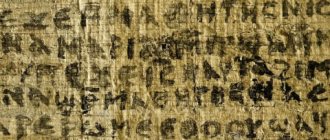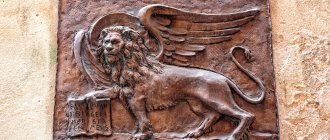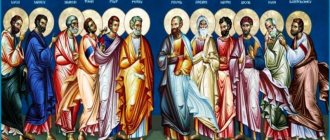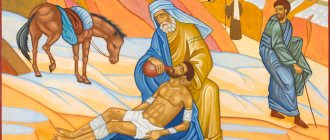After John the Baptist baptized Christ in the Jordan, the Holy Spirit led Him into the desert. But the Devil did not sleep and decided to subject the Savior to temptations here so that He would renounce his mission.
While Jesus was fasting for forty days and nights, the Enemy of the human race tempted him with various temptations. Christ won this personal confrontation with the one who called himself the head of earthly kingdoms, thereby showing that after baptism a person must courageously endure any temptation without succumbing to it.
The painting of the Temptation of Christ is the plot of the New Testament about the forty-day fast of the Savior in the desert
The temptation of Christ in the desert is the plot of the New Testament. It tells about what the Savior experienced during his forty-day fast in the desert, where He retired after his baptism. The narrative speaks of the temptations that the Devil subjected Jesus to make him doubt his Divine mission.
In Christianity, the temptation of Christ is understood as one of the proofs of the two natures in Jesus. At the same time, His wounding of the Devil is understood as an example of the correct struggle against the forces of evil and the result of the grace-filled fruits of baptism.
"The Temptation of Christ." Juan de Flandes, 16th century. The Temptation of Christ in the Desert is a plot of the New Testament, telling about the forty-day fast of Christ in the desert after His baptism and His temptation at that time by the Devil
Tradition says that these events of the Gospel took place on a mountain located near the city of Jericho. Now it is called the Mount of Temptation and a monastery was erected on it. This place is often visited by Orthodox pilgrims, including those from Russia.
The pilgrimage to Mount Temptation was once financed by members of the Russian imperial family. Some of them have been here themselves.
All the evangelists, except John, talk about the temptation of Christ in the desert.
You can read about the forty-day fast of Jesus Christ, as well as about his temptation after it by the Devil, in almost all the evangelists except one - John. Theologians note that Matthew and Luke talk about this event in great detail and their stories coincide in detail. The Apostle Mark speaks very briefly about this, without much detail:
(Mark 1:13)
“... He was there in the wilderness for forty days, tempted by Satan, and was with the beasts; and angels served Him"
Ivan Kramskoy.
Christ in the desert. 1872 After the baptism of Jesus Christ, led by the Holy Spirit, he retired into the desert in order to prepare in solitude and prayer for the fulfillment of his mission. The Gospel story says that after his baptism, led by the Spirit, Jesus Christ retired into the desert. Here he gathers in solitude and prayer to prepare for the fulfillment of the mission for which He came into the world. Savior forty days
(Luke 4:2)
“I was tempted by the Devil and did not eat anything during these days, but after they were over, I was hungry at last”
After this, the Devil tries to tempt him to sin, like any person, thereby repeating the fall of Adam.
Jesus Christ was tempted by the devil 3 times in the desert.
The Son of God was tempted by the Enemy of the human race three times, after which He left Him and Angels began to serve Him. The temptation of Christ is mentioned in several books of the New Testament, for example, the Apostle Paul speaks about it in the Epistle to the Hebrews:
(Heb. 2:18)
“For just as He Himself suffered when He was tempted, He is able to help those who are tempted.”
The Gospel of Nicodemus, pre-revolutionary edition.
The Gospel of Nicodemus is the only apocryphal Gospel that mentions the temptation of Christ in the desert. This plot differs from other gospel stories in that it is not revealed in apocryphal literature. He is only mentioned briefly in the Gospel of Nicodemus. This is a dialogue between the Devil and hell before Christ descends there:
“...why are you pondering and afraid to accept Jesus? The enemy is mine and yours. I tempted Him and caused the elders of the Jews to slander and be angry with Him.”
Came to save everyone
In Judea of the 1st century AD, when Old Testament prophecies began to come true one after another, many people expected the appearance of Christ. Together with everyone else, Christ was also expected by... the devil - so that, if not to kill, then at least to prevent Him from fulfilling His mission. For example, everyone remembers from the Gospel how, as if by satanic will, King Herod, as soon as he heard that the King of the Jews had been born in Bethlehem, ordered to kill all the babies in the city. And who knows, the attempts to kill the Savior in childhood would not have been repeated if the Virgin Mary had openly announced to the people who Her son Jesus really is. Therefore, as it is written in the Gospel, the Lord entered into open ministry when he was already about thirty years old (Luke 3:23) - that is, at the age of a mature man, according to the ideas of the Jews, when a person is already responsible for himself, has the right to speak and teach in the synagogue. And, as the Gospel says, the first thing the Son of God did was come to the Jordan River to receive ablution (baptism) from John the Baptist, revered by all as a prophet and righteous man.
John's baptism was a baptism of repentance—in other words, people who desired reconciliation with God publicly testified to their sins and asked their Creator for forgiveness through this ritual washing. Such baptism did not yet carry the power of the Sacrament, as it became in Christianity. Washing in the waters of the Jordan River (not any special one at that time, but simply the only large river in Judea), which John proposed, was unable to actually cleanse a person from sin. It did not even cancel the offering of the temple sacrifice for sin, required by the Old Testament Law. However, washing in front of everyone, practically publicly admitting “I have sinned against You,” certainly helped a person to repent and fight against sin, so as not to repeat it in the future. And people wanted to be cleansed from their sins all the more because John preached: the long-awaited Messiah is about to come, repent, for the Kingdom of Heaven is at hand (Matthew 3:2).
But then the inexplicable happens. Yes, the Messiah really comes, and John recognizes Him, testifies of Him as the Savior of the world - but the Savior who revealed Himself says that He came... to be baptized!
One can understand how surprised John was, who, having heard Jesus’ request for baptism, restrained Him and said: I need to be baptized by You, and are You coming to me? (Matthew 3:14). It wasn't just modesty. John probably asked himself the question - how is salvation possible for sinners, if even the Savior, the Messiah, the greatest Righteous One, for whom the Jews had been waiting for hundreds of years, wants to publicly repent of their sins?
Let us now remember what Christians have known for two thousand years, but which no one except the Virgin Mary knew at that time. Jesus is not just a righteous man, He is the Son of God, God Himself, incarnate and became man. And as God, He has no sin on Himself. But that is precisely why, paradoxically, He came to be baptized by John - so that before all the people who had ever come here and washed away their iniquities, before all the people who had long since died and before everyone who had yet to be born, to forever testify: He, who has no sin on Himself, does not disdain sinful people, He came to save everyone. God became incarnate, became the same as all people, and so He came to wash himself in the waters of repentance, like a simple sinner, and voluntarily take upon Himself the crimes of others in order to later atone for them on the Cross.
The fact is that in the world, without a doubt, there is not a single completely righteous person free from sin. In relationships between people, it always happens that whoever offended a loved one at least once, whoever violated at least one commandment of love towards him, thereby violated them all. The relationship between man and God must be precisely a relationship of love, and then what kind of righteousness can we talk about, how can a person be “a little” faithful to God? Therefore, although Jesus was not guilty of absolutely anything, by being baptized, He thereby took upon himself absolutely all sins, and not just those that were named out loud on the banks of the Jordan. Being innocent, He allowed Himself to be blamed for everything.
Since then, the phrase “taking sin upon oneself” has long become popular, but in its own sense it refers only to Christ, and originates in the words of John, who realized after the baptism of Christ why He came to earth: behold the Lamb of God who takes away take upon himself the sin of the world (John 1:29). As Saint John Chrysostom said about this, “He who could destroy the sins of the entire human race was already, without a doubt, sinless.” In essence, Christ took upon himself the disease of our nature, which we ourselves cannot cope with, in order to heal us from it and destroy the very cause of this disease - sin. It is not for nothing that the feast of the Baptism of the Lord is also called Epiphany, because God the Father, who at the moment of Jesus’ baptism uttered the words This is My beloved Son, in whom I am well pleased (Matthew 3:17), revealed to the whole world a revelation of His love for people, for the sake of whose salvation gave his Son.
The Devil prepared three temptations for Christ in the desert
The Christian Church believes that the temptation of Christ in the desert after a forty-day fast was directed against the human nature of Jesus, influencing which the Devil hoped to seduce Christ onto the wrong path.
Thus, the “new Adam”, who incarnated in order to save humanity, during his stay in the desert fought with the Devil, who longed to maintain power over people. For this purpose, the Enemy of the human race prepared three temptations for Jesus.
"Christ led by the Spirit into the wilderness." William Hall, 1908 Christ, led by the Spirit into the desert, went there, among other things, to point out the trinity of Divine persons
These three temptations affect almost all sinful areas. In the Holy Scriptures they are called as follows:
- temptation of hunger;
- temptation of pride;
- temptation by faith.
Jesus Christ went into the desert to fast after his baptism.
Many believers ask: why was Christ sent by the Spirit into the desert? The Son of God could well have avoided all temptations. The Monk Ephraim the Syrian responds to this in his writings as follows:
“... so that none of the unbelievers have an excuse to say that the Spirit is later and lower than the Son.”
Thus, Christ’s stay in fasting and prayer in the desert after baptism is, among other things, evidence of the trinity of Divine persons who all participate in this.
Job North Russian icon, 17th century. There is a parallel with the temptation of Christ in the wilderness and the trials of Job
There are parallels in the Bible with the temptation of Christ in the wilderness with the trials of Job. The Prophet was also subjected to three tests and in the last test Satan also offered to worship him.
In addition, analogies are seen with the Exodus of the Jews from Egypt, for example, the Jews crossed the Jordan, and Jesus Christ was baptized in it, the Savior fasted for forty days and the Israelites experienced hunger in the desert.
The thoughts of the Church Fathers on this topic are connected with the sacrifice of Christ
But this does not mean that fathers have never asked this question. The thoughts of some of them on this matter were expressed in the context of consideration of another, more important topic related to the sacrifice of Christ. Some fathers expressed their thoughts in words spoken on great Christian holidays, while others, answering individual questions, only briefly added their thoughts regarding this area. As for the source of patristic wisdom - the Holy Scriptures - it, unfortunately, does not give a specific answer. Rather, the Bible contains contradictory evidence, of a thesis or contextual nature, which we will attempt to analyze. Also important for us is the liturgical heritage, because church hymnography is one of the forms of recording theological tradition.
The first temptation of Christ is the temptation of hunger
The first temptation of Jesus Christ in the desert is that the Devil offers him, who fasted for a long time, to turn stones into bread:
(Matt. 4:3)
“If you are the Son of God, command that these stones become bread”
To this the Lord answers him
(Matt. 4:4)
“It is written: Man shall not live by bread alone, but by every word that proceeds from the mouth of God.”
“The Temptation of Christ by Hunger”, Simon Benin, 16th century.
The first temptation that Christ experienced in the desert was the temptation of hunger. In this case, the Devil had the hope that the hungry Christ would be tempted, and, having once created a miracle for himself, would do the same in the future. To do this, according to Satan’s plan, He will protect himself from the crowd during the execution by angels, descend from the cross and call the prophet Elijah for help (Matthew 26:53, 27:40-49).
Thus, the evil one wants the work of saving humanity through the suffering of Christ on the cross to not be realized.
Did the devil have a chance to win?
In itself, this gospel story will not seem at all strange to someone for whom Christ is just an ordinary person. You never know, he wanted to be baptized - and was baptized, he wanted to impose a fast on himself - that’s also understandable, but temptations - they happen to everyone. But if you think about the fact that Jesus of Nazareth is the incarnate Son of God, God who appeared on earth, then questions already arise. How do Christians explain that their God appears to be fasting? How could the devil even dare to approach Him and tempt him - and could Christ really succumb to persuasion and sin?
Of course not, the Christian will answer, God is sinless and holy in His essence, and there is no darkness in Him (1 John 1:5), so Satan tried in vain. But meanwhile, the interesting thing in this whole story is that the devil somehow still had hope that Christ would submit to him. What could we be talking about?
The second temptation is the temptation of pride
The second test that the Devil prepared for Christ is the temptation of pride. To do this, the Devil takes Him and carries Him to the edge of the abyss. After this he says:
(Matt. 4:6)
“If you are the Son of God, throw yourself down, for it is written: He will command his angels concerning you, and in their hands they will bear you up, lest you dash your foot against a stone.”
To this Jesus replied:
(Matt. 4:7)
“It is also written: Thou shalt not tempt the Lord thy God.”
"The Temptation of Christ" (mosaic of St. Mark's Cathedral).
12th century The second temptation of Christ was that the Devil suggested that Christ perform a miracle and thereby amaze the imagination of people, and also entice them with him . In the second temptation, the Devil proposed to miraculously strike the imagination of people who were expecting the coming of the Messiah. Thus, he wanted Christ to easily drag them along without morally correcting them.
Jesus rejected this temptation, and He also showed that one should not unnecessarily expose oneself to danger by testing the miraculous power of God. In this temptation, the Devil quotes to Jesus the verses of Psalm 90, which shows believers the benefits of full trust in God.
The last temptation of Christ in the desert - the temptation of faith
Seeing that he was unable to tempt Christ, the Devil prepared a third and final test for him. He showed Him all the kingdoms of the world over which He had authority, and said:
(Luke 4:6-7)
“I will give you power over all these kingdoms and their glory, for it has been given to me, and I give it to whomever I want; So, if You worship me, then everything will be Yours"
Then Jesus answered:
“Get behind Me, Satan; It is written: “Worship the Lord your God, and serve Him only.”
“The Temptation of Christ on the Mountain” (fragment of Duccio’s “Maesta”, 1308-1311).
The last temptation of Christ consisted in the Devil offering Christ power over all the kingdoms subject to him. Here the Devil decided to confuse the human spirit of Christ and sow doubts about the possibility of Christ carrying out the work of saving mankind. The Savior rejects this temptation, which shows that he does not recognize the power of Satan over the world, which belongs to God, to whom worship is due.
Thus, Jesus Christ, tempted by Satan, successfully resists all his attempts to prevent Him from fulfilling His Divine mission.
Immediately after the third temptation, the Devil leaves Christ “until the time”
Immediately after Satan was defeated in his attempt to tempt Christ for the third time, he, according to the Evangelist Luke,
(Luke 4:13)
"until the time" leaves Him
The Scripture says that later the Enemy of the human race again begins to tempt him through the Jewish people and even through his disciples the apostles, plotting all sorts of intrigues. In addition, Evangelist Mark says that in the desert Jesus
(Mark 1:13)
"I was with the animals"
It is believed that this is an indication that Christ (the new Adam) was surrounded by animals who did not dare to harm him, just like the old Adam in paradise.
Video: Temptation in the desert. Archpriest Oleg Stenyaev. At 12 minutes 19 seconds, the author says that after the third temptation, the Devil left Christ “for the time being.”
It should be noted that during each of the temptations, Christ does nothing, but only speaks to Satan. He does this because nothing good can be expected from the Devil, and the word is the main weapon of the evil one.
That is why, as John Chrysostom notes, “the word of His mouth condemned Satan.” Thus, the Devil is defeated by Christ by the Word of God, and not by human action.
Jesus Christ defeated the wiles of the Devil in the desert with the Word of God.
The Monk Ephraim the Syrian points out that the baptism of Christ consisted of three immersions and three temptations. The passage of Jesus Christ through the temptations of the Devil precisely after his baptism is an indication of the beneficial fruits that baptism can give.
He was sent to the desert by the Holy Spirit, among other things, in order to show the struggle against the forces of evil, and what strength communion with the Lord through the sacrament of baptism gives a person in this.
The deceived deceiver theory
There is a theological point of view in Christianity called the deceived deceiver theory . According to it, the devil, being a murderer from the beginning (John 8:44), having deceived the first people in paradise, was deceived by Jesus Christ Himself when, hiding under the guise of a mortal human body, he struck the devil with His Divinity. The theory itself has never been elevated to the rank of dogma and does not claim to be the absolute truth, but at the same time it has a fairly strong argument. For example, verse 27 of Psalm 17, defining the relationship between God and man, literally reads like this: “You deal mercifully with the merciful, sincerely with a sincere man, purely with the pure, and with the evil one according to his wickedness.” If the Lord deals with an evil man according to his wickedness, then all the more, does He not have the right to do the same with the one who is the father of lies (John 8:44). Often, theologians who do not profess this theory rightly note that God is the truth (John 14:6), that there is no untruth in Him (John 7:18), and that He is incapable of actions that are characteristic of fallen spirits and fallen people . But here the cunning on the part of God should not be understood as deception in the strict sense; rather, according to St. Athanasius the Great, this is a military maneuver: “He who sees that his enemy is running away in fear pretends to be weak in order to draw the enemy into battle: the runner, having fallen for feigned weakness, confidently goes on the offensive, and the mighty athlete who lured the enemy with feigned weakness , here he defeats him with his strength. So the Lord, having lured [the devil] with human weakness, in the fight against the enemy strengthened human strength with his [Divine] power” (Athanasius the Great, Saint. On the Passion and Cross of the Lord. 14).
Saint Gregory of Nyssa, in response to bewilderment about whether it is possible for God to deceive, says that whoever has the truth before his eyes will agree that this was precisely what was most characteristic of justice and wisdom (see for more details: Nesmelov Victor. The dogmatic system of Gregory of Nyssa ).
Pope Leo the Great, speaking about the possibility of God using cunning against the devil, states: “Of course, [the devil] would not have lost his original power over the human race if he had not been defeated by that (by deception - Priest I.P.) than he once enslaved people” (Word for the Nativity of Christ).
And Origen directly says that the life of the Savior, from the very moment of His coming to earth, was, in relation to the devil, a whole chain of deceptions: “Mary’s virginity was hidden from the prince of this world: hidden thanks to Joseph, hidden thanks to their marriage; hidden because the devil thought Mary had a husband. If she did not have a spouse and, as the devil thought, a husband, then Christ could not be hidden from the prince of this world. The devil would immediately suspect: how did she, if she did not sleep with her husband, suddenly become pregnant? This means that He was conceived from God, which means that His nature is higher than human” (Homilia VI on the Gospel of Luke).
The same opinion is shared by another Western father - St. Leo the Great Pope of Rome, who in his word on the Nativity of Christ claims that Christ, at the time of his birth, hid the Divine power under the cover of our weakness; the cunning of the careless enemy was ridiculed, who decided that the Nativity of the Child, intended for the salvation of the human race, was just as subject to him as the birth of all [other] beings born... and, knowing to what extent human nature was poisoned, in no way believed “that He escaped original sin, Whom He recognized as mortal by so many signs.”
Origen himself, in a sense, can even be considered the founder of this theory. Briefly summarized by the professor of the Kazan Theological Academy, Viktor Nesmelov, it is stated as follows: “In His incarnation, He hid His Divine power from the devil, so that the devil hoped to make Him his slave, just as Christ defeated him” (Nesmelov Viktor. Dogmatic system of Gregory of Nyssa). Origen's theory received its development from another, already mentioned by us, the Cappadocian holy father Gregory of Nyssa. Like Origen, Saint Gregory viewed it in the context of the Sacrifice of Christ. In his opinion, the Son of God became incarnate so that the devil would not recognize Him and consider Him to be an ordinary person. Which he can easily keep in his power... The devil did not know that this was God ; he judged by the flesh and thought that by death he would defeat the Redeemer of people, but he was cruelly deceived: “having swallowed the bait of the flesh, he is pierced by the milk of the Divine” (Nesmelov Viktor. The dogmatic system of Gregory of Nyssa).
A similar image of bait is given by the Western Father Isidore of Seville. In his opinion, the devil is deceived by the death of the Lord, like a bird. Where the human nature of Christ is a bait, and the Divine nature is a trap for a bird - the devil (Sentences. Lib. I, sar. XIV. 10-13).
Metropolitan Hilarion (Alfeev) also sees in the catechetical speech of St. John Chrysostom, read at Easter Matins, the motives that the devil was deceived: “hell was “mocked” by the Resurrection of Christ and was “caught” for not noticing the invisible God under the visible man.” and further cites an excerpt from the homily of St. John “hell was saddened when it met You: it was saddened because it was abolished, it was saddened because it was ridiculed... He accepted the body - and touched God, accepted the earth - and met heaven, accepted what he saw - and was caught in what I did not see” (Ilarion (Alfeev), Metropolitan. The Sacrament of Faith).
In addition to all of the above, one can also cite evidence from the liturgical tradition of the Church. Thus, in the Menaion on the Feast of Pentecost, one of the kneeling prayers contains the following words: “I caught the beginning of the evil and deep serpent with God-wise flattery (i.e., deception).
The Temptation of Christ is not a very common subject in art
In fine art, the temptation of Christ is not recognized as a common plot. Most often it is present in pictorial depictions of the entire cycle of events in the life of Christ as one of its episodes.
All three temptations are depicted, as well as simply Christ standing next to the Devil on the top of the mountain. In the first case, the first temptation is presented in large detail in the foreground, and the second two are placed in the background.
“Temptation of Christ” (stamp of the icon of the Almighty Savior, 1682). In Orthodox iconography, the plot of the temptation of Christ in the desert is usually depicted on icons of the Baptism of the Lord
Orthodox painting is characterized by the placement of a scene of the temptation of Christ on the icons of the Baptism of the Lord. Typically, a painting with the plot of the temptation of Christ has three compositions according to the number of temptations:
- “Jesus in the Desert”: Temptation by Hunger.
- “Jesus on the wing of the temple”: The temptation of pride.
- “The Temptation of Christ on the Mountain”: Temptation by Faith.
In addition to the image of Christ in the paintings dedicated to his temptation, images of the Devil are also interesting. Thus, in Romanesque and Gothic art, as well as during the Early Renaissance, Satan was usually depicted as the spirit of darkness.
Such images are characterized by the image of a demon with horns, a scaly body, wings and claws on his hands and feet. During the High Renaissance, Italian artists painted him as a “fallen angel”, in the image of a comely youth.
Paintings with the plot of the temptation of Christ in the desert have 3 compositions - according to the number of temptations.
Since this plot concerns the image of the Lord, the Christian Church has always closely followed the work of representatives of art affecting it. For example, Martin Scorsese’s film “The Last Temptation of Christ” was subjected to severe criticism from Christian circles. In some countries around the world it was even banned from being shown.
By leaving a comment, you accept the user agreement









